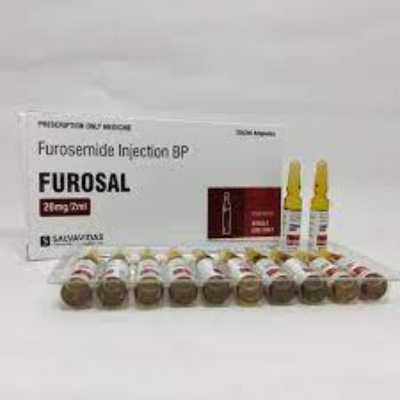


Hypertension
Oedema
All conditions requiring prompt diuresis including:
Oedema of cardiac, pulmonary, hepatic or renal (including nephrotic syndrome) origin,
Peripheral oedema of mechanical obstruction or venous insufficiency.
Maintenance therapy of mild oedema of any origin.
Hypertension.
The following dosing regimes may be suitable:
Tablets can be crushed and mixed with water or injection solution diluted and given by mouth.
0.5mg/kg to 2 mg/kg given one or two times a day (or given once a day if postmenstrual age under 31 weeks).
Tablets can be crushed and mixed with water or injection solution diluted and given by mouth.
Diuresis lasts for approximately 4 hours following administration so the dosing regime can be adjusted to suit the patient's requirements.
Cardiac glycoside toxicity
Addison's disease
Anuria
Breastfeeding
Dehydration
Galactosaemia
Hepatic coma
Hepatic encephalopathy
Hereditary fructose intolerance
Hypotension
Hypovolaemia
Long QT syndrome
Pre-coma associated with hepatic cirrhosis
Renal damage secondary to nephrotoxic agents
Renal impairment secondary to hepatotoxic agents
Severe hypokalaemia
Severe hyponatraemia
Torsade de pointes
Elderly
Family history of long QT syndrome
Hypoproteinaemia
Predisposition to hypotension
Premature infants
Adrenal disorder
Benign prostatic hyperplasia
Diabetes mellitus
Electrolyte imbalance
Glucose-galactose malabsorption syndrome
Gout
Hepatic impairment
Hepato-renal syndrome
History of gout
History of torsade de pointes
Hypercalcaemia
Lactose intolerance
Metabolic alkalosis
Pregnancy
Renal impairment
Urinary obstruction
Use furosemide with caution in pregnancy.
Furosemide has been given after the first trimester of pregnancy without causing foetal or newborn adverse effects. It should only be given during pregnancy if strictly indicated and for short-term treatment.
Acute renal failure
Aggravation of metabolic alkalosis
Agranulocytosis
Anaphylactic reaction
Anaphylactoid reaction
Aplastic anaemia
Arrhythmias
Blood urea increased
Blurred vision
Bone marrow depression
Confusion
Decrease in plasma calcium
Decreased glucose tolerance
Dehydration
Delayed reactions
Diarrhoea
Dizziness
Drowsiness
Dry mouth
Eosinophilia
Erythema multiforme
Exfoliative dermatitis
Fever
Gout
Haemolytic anaemia
Headache
Hearing loss (reversible)
Hepatic encephalopathy
Hypochloraemia
Hypokalaemia
Hypomagnesaemia
Hyponatraemia
Hypotension
Hypovolaemia
Impaired concentration
Increase in plasma triglyceride concentration
Increase in serum cholesterol (transient)
Increase in serum transaminases
Increased thirst
Interstitial nephritis
Intrahepatic cholestasis
Jaundice
Leucopenia
Light-headedness
Malaise
Metabolic alkalosis
Muscle cramps
Muscle weakness
Nausea
Nephrocalcinosis
Nephrolithiasis
Orthostatic dysregulation
Pancreatitis
Paraesthesia
Photosensitivity
Precipitation of diabetes
Pruritus
Psychiatric disorders
Purpura
Rash
Sensation of pressure
Serum creatinine increased
Severe bullous lesions
Shock
Tetany
Thrombocytopenia
Thrombosis
Tinnitus
Toxic epidermal necrolysis
Urinary retention
Urticaria
Vasculitis
Visual disturbances
Vomiting
Weakness
Yellow vision